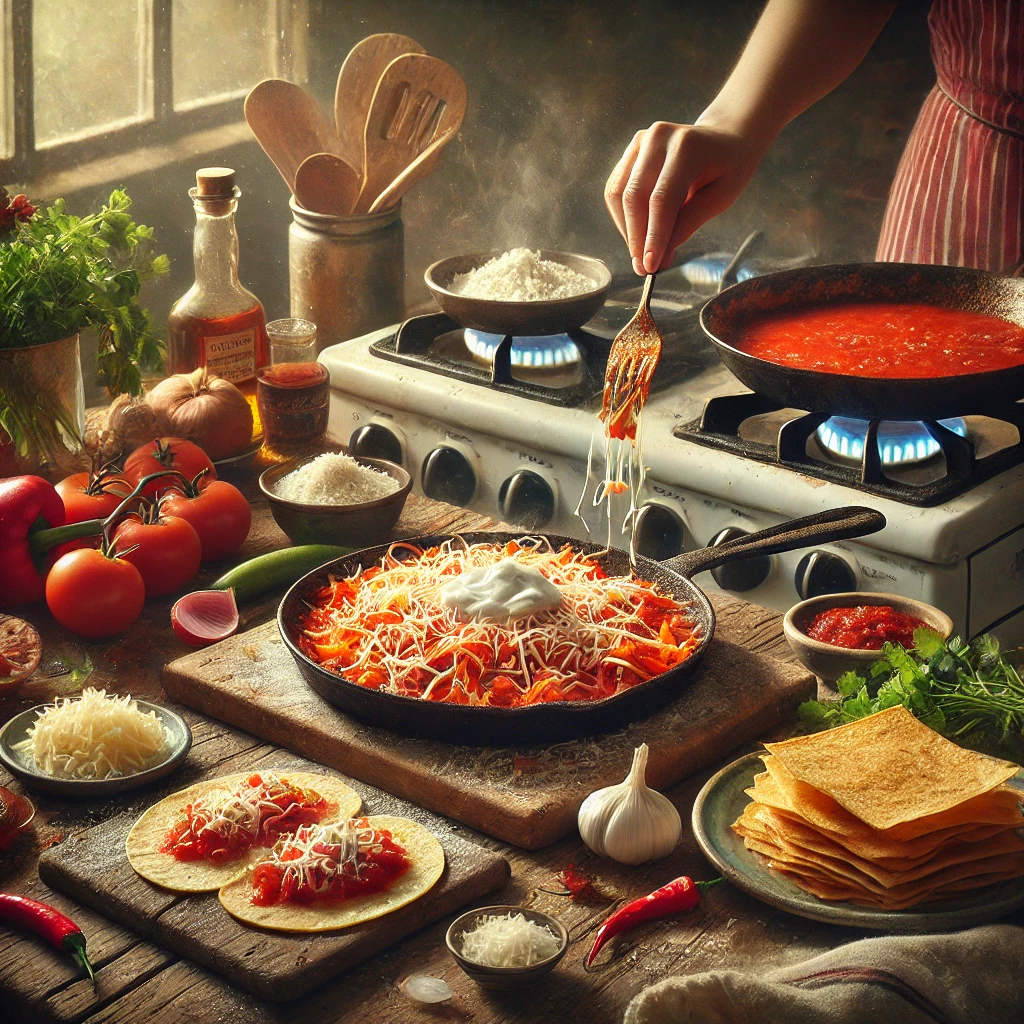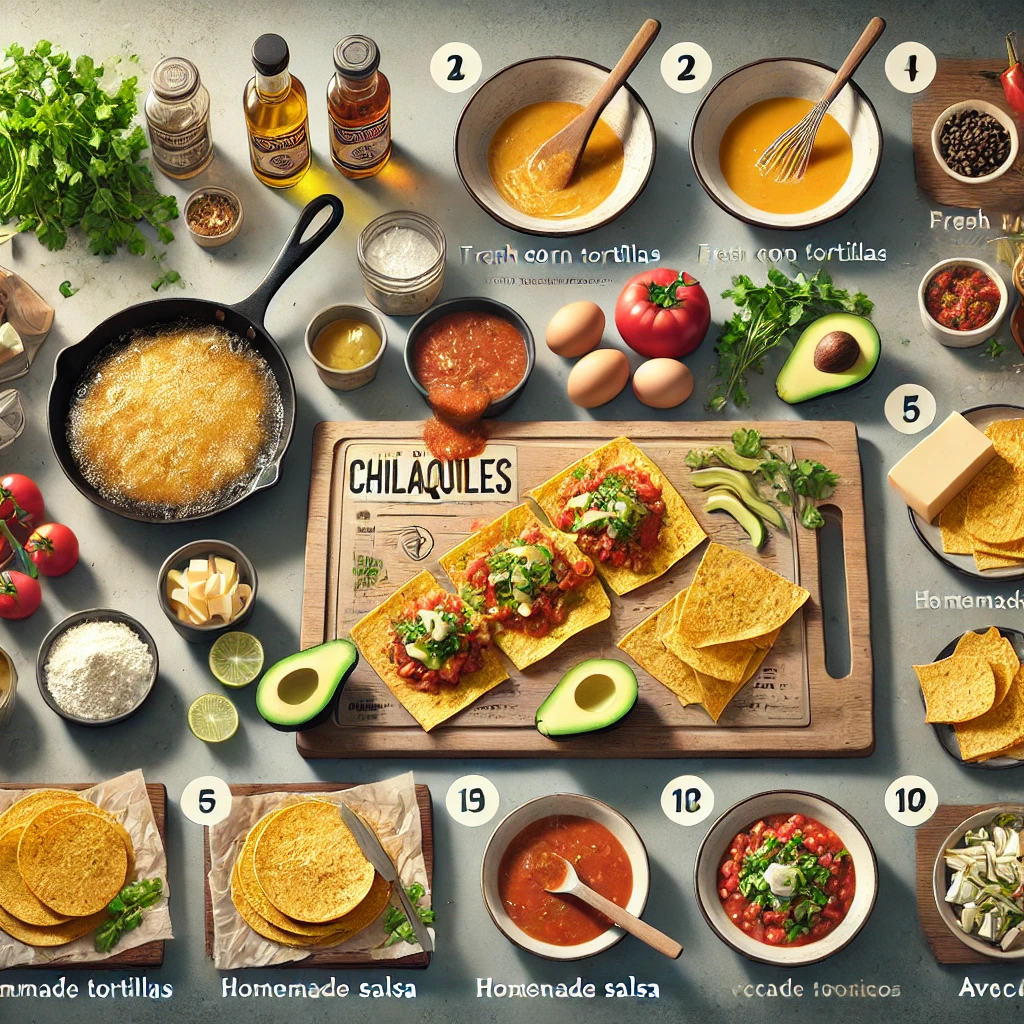Chilaquiles, a classic Mexican dish, has long been a staple in households and restaurants. This savory delight is not just a meal; it’s a celebration of Mexican culture, tradition, and culinary ingenuity. Whether enjoyed as a hearty breakfast, brunch, or even dinner, chilaquiles offer a unique gastronomic experience that transcends the ordinary. This article delves into Celebrating chilaquiles’ history, variations, and cultural significance, providing an expert perspective on why this dish deserves a special place in your culinary repertoire.
The Origins of Chilaquiles
Chilaquiles date back to pre-Columbian times, with roots in Aztec cuisine. The word “chilaquiles” comes from the Nahuatl language, where “chīlāquilitl” refers to a dish made with chiles and tortillas. Traditionally, it was a way to utilize leftover tortillas, turning them into a flavorful and nourishing meal. Over centuries, this dish has evolved, yet its core remains the same: crispy tortilla pieces drenched in a rich, spicy sauce.
The Art of Making Chilaquiles

At its essence, chilaquiles consist of fried or toasted tortilla pieces, typically cut into quarters, that are simmered in either red or green salsa. However, the dish is highly versatile and can be customized with various toppings and ingredients, including:
- Protein Additions: Shredded chicken, fried eggs, or chorizo can be added for an extra layer of flavor and nutrition.
- Cheese and Cream: Crumbled queso fresco, cotija cheese, and a drizzle of Mexican crema add creaminess and balance to the dish.
- Onions and Cilantro: Freshly chopped onions and cilantro enhance the flavor profile with their crisp, herbal notes.
- Avocado and Radishes: These toppings bring a refreshing contrast in texture and taste.
The key to perfect chilaquiles is the balance of textures—crispy tortillas that hold under the sauce but not too long to become soggy.
Celebrating Chilaquiles: A Cultural Tradition
In Mexico, chilaquiles are more than just food; they represent a celebration of togetherness. This dish is commonly served during family gatherings, weekend brunches, and festive occasions. Each region in Mexico offers its twist on chilaquiles, from the mole-coated chilaquiles of Oaxaca to the tangy, tomatillo-based versions in central Mexico. The diversity of preparations showcases the adaptability of the dish, making it a culinary canvas for creativity.
Why Chilaquiles Deserve Recognition
Chilaquiles are not just about taste; they embody a more profound cultural significance. They reflect the Mexican tradition of resourcefulness, turning simple, everyday ingredients into something extraordinary. Moreover, chilaquiles have gained international recognition, appearing on menus worldwide, from high-end restaurants to casual eateries.
As global interest in Mexican cuisine continues to rise, chilaquiles stand out as a dish that offers an authentic taste of Mexico’s rich culinary heritage. Celebrating chilaquiles is celebrating the ingenuity and warmth of Mexican culture.
Chilaquiles Around the World: A Growing Trend
As Mexican cuisine continues to influence global culinary trends, chilaquiles have begun to find a place in kitchens and restaurants far beyond Mexico’s borders. For example, chilaquiles have become a popular brunch item in the United States, often featured on menus alongside other Mexican-inspired dishes like huevos rancheros and avocado toast. Chefs in cities from Los Angeles to New York are putting their spin on the traditional recipe, introducing fusion versions that incorporate local ingredients and global flavors.
Chilaquiles are also gaining traction in Europe, particularly in trendy eateries celebrating international street food. The dish’s adaptability allows chefs to experiment with different salsas, cheeses, and toppings, making it an appealing option for those looking to offer something both familiar and novel. This global expansion of chilaquiles reflects a broader appreciation for Mexican cuisine, which is increasingly recognized for its complexity, depth, and cultural significance.
Tips for Making Perfect Chilaquiles at Home

For those looking to recreate the magic of chilaquiles at home, a few expert tips can help you achieve restaurant-quality results:
- Choose Quality Tortillas: The foundation of great chilaquiles is the tortilla. Opt for high-quality corn tortillas, preferably slightly stale ones, as they will fry up crispier and hold their texture better when combined with the sauce.
- Don’t Skimp on the Salsa: The salsa is the heart of chilaquiles, so using fresh, homemade salsa can make all the difference. Whether you prefer red or green salsa, ensure it’s well-seasoned and has a good balance of acidity, heat, and depth of flavor.
- Control the Simmer: The key to avoiding soggy chilaquiles is to simmer the tortillas in the salsa just long enough to absorb the flavor without losing their crispiness. If you prefer softer chilaquiles, you can simmer them a bit longer, but be careful not to overdo it.
- Experiment with Toppings: While traditional toppings like cheese, crema, and cilantro are always a good choice, don’t hesitate to get creative. Sliced radishes, pickled onions, or even a dollop of guacamole can add a new dimension to your chilaquiles.
- Serve Immediately: Chilaquiles are best enjoyed fresh off the stove when the tortillas still have a bit of crunch. If you must prepare them beforehand, consider keeping the tortillas and salsa separate until just before serving.
The Future of Chilaquiles: A Dish with Enduring Appeal
As chilaquiles continue to gain popularity worldwide, their future looks bright. This humble dish has proven its versatility and appeal across cultures, making it a prime candidate for continued innovation and adaptation. From gourmet versions served in upscale restaurants to simple, comforting plates enjoyed at home, chilaquiles are a dish that resonates with people from all walks of life.
In a world where food trends come and go, chilaquiles stand out as a dish with enduring appeal. Their rich history, cultural significance, and endless adaptability ensure that they will remain a beloved part of Mexican cuisine—and the global culinary landscape—for years to come.
Embracing the Tradition: How to Celebrate Chilaquiles in Your Kitchen

To celebrate chilaquiles:
- Consider hosting a brunch or dinner centered around this iconic dish.
- Invite friends and family to join the preparation, allowing everyone to customize their plate with various toppings.
- Pair the chilaquiles with traditional Mexican beverages like horchata or a refreshing agua fresca, and you’ll create an experience that’s both delicious and culturally enriching.
By sharing the tradition of chilaquiles with others, you enjoy a delightful meal and help preserve and promote a piece of Mexican culinary heritage. Whether you’re a lifelong fan of chilaquiles or new to this flavorful dish, there’s always something new to discover and enjoy.
This continuation of the article further explores the growing global influence of chilaquiles, offers practical tips for making them at home, and emphasizes the dish’s lasting appeal. Celebrating chilaquiles in your kitchen allows you to experience the rich cultural history and modern versatility that make this dish unique.
Frequently Asked Questions (FAQs) About Chilaquiles
- What are chilaquiles?
Chilaquiles are a traditional Mexican dish made from fried or toasted tortilla pieces that are simmered in salsa and topped with various ingredients like cheese, crema, onions, and sometimes proteins like chicken or eggs. The dish is known for its rich flavors and is typically enjoyed for breakfast or brunch.
- What is the difference between red and green chilaquiles?
The primary difference lies in the type of salsa used. Red chilaquiles are made with red salsa, usually based on tomatoes and red chiles, giving them a slightly sweeter and smokier flavor. Green chilaquiles are made with green salsa, typically using tomatillos and green chiles, resulting in a tangier and fresher taste.
- Can chilaquiles be made with store-bought tortillas?
Yes, chilaquiles can be made with store-bought tortillas. However, slightly stale or day-old tortillas are recommended as they hold up better when fried and simmered in the sauce. You can also make your tortillas for a more authentic taste.
- Are chilaquiles spicy?
The level of spiciness in chilaquiles depends on the type of salsa used. Some salsas are mild, while others can be pretty spicy. If you prefer less heat, opt for a milder salsa or reduce the amount of spicy chiles in your recipe.
- Can I make chilaquiles ahead of time?
Chilaquiles are best enjoyed fresh, as the tortillas can become soggy if left to sit too long in the salsa. However, you can prepare the salsa and other components in advance and combine them just before serving. This way, the tortillas will retain some of their crispiness.
- What are some popular toppings for chilaquiles?
Popular toppings include crumbled queso fresco or cotija cheese, Mexican crema, chopped onions, cilantro, avocado slices, and fried eggs. You can also add shredded chicken, chorizo, or beans for a heartier meal.
- Can chilaquiles be made vegan or vegetarian?
Absolutely! Chilaquiles can easily be adapted to suit vegan or vegetarian diets. Use vegetable oil to fry the tortillas, and opt for plant-based toppings like avocado, vegan cheese, and beans. For a vegetarian version, you can include eggs and dairy-based cheese.
- What is the difference between chilaquiles and nachos?
While both dishes involve tortillas and toppings, chilaquiles and nachos are distinct in their preparation and presentation. Chilaquiles involve simmering tortilla pieces in salsa, resulting in a softer, more flavorful dish. On the other hand, nachos are typically made by layering tortilla chips with cheese, beans, and other toppings and then baking them until the cheese is melted.
- Can I use leftover tortilla chips to make chilaquiles?
Yes, leftover tortilla chips can be used to make chilaquiles. They may be slightly softer than freshly fried tortillas, but they will still absorb the salsa and create a delicious dish.
- What are some regional variations of chilaquiles in Mexico?
Chilaquiles vary by region in Mexico. For example, in Oaxaca, chilaquiles are often made with mole sauce, giving them a rich, deep flavor. In central Mexico, green chilaquiles made with tomatillo salsa are popular. Some regions also add local ingredients like epazote, a traditional herb, to enhance the flavor.

